Neil Koenig, ideaXme Board Advisor and former Senior BBC Series Producer interviews Artist, Anthony McCall.
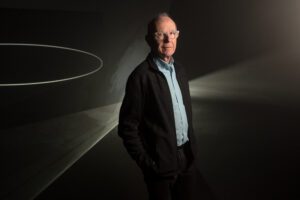
Picture shows Artist, Anthony McCall in his exhibition at The Hepworth Wakefield, Wakefield.The exhibition Anthony McCall: Solid Light Works opened 16 Feb – 3 June 2018 at The Hepworth WakefIeld. Picture taken 14/02/2018.
Neil comments: In the face of today’s flood of information from the internet and social media, it can sometimes take courage to retain belief in the strength of self-generated ideas. But for some, it can pay off. As the British artist Anthony McCall explains, “there’s a certain moment in any artist’s life where your own ideas become more vivid than anyone else’s, for yourself”. Anthony McCall is certainly no stranger to vivid ideas. His ground-breaking piece from 1973, “Line Describing a Cone”, has had a big impact not only on his own output, but also on the work of many other artists. After studying graphic design at Ravensbourne college in the 1960s, Anthony McCall moved to New York in the early 1970s, and he has lived and worked there ever since. He is perhaps best known for his “solid light” installations. His work has been the subject of numerous solo and group exhibitions at institutions all over the world and can be found in the collections of many major museums. In this interview with me for ideaXme, Anthony McCall talks about how he first became interested in becoming an artist, how he approaches the process of creating his works, and about his future plans, including an upcoming show at Galerie Rudolfinum in Prague, and a major exhibition which will be celebrating his work and his influence on other artists, at Tate Modern in London in summer 2024.
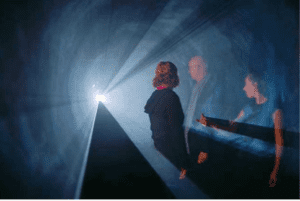
Line Describing a Cone (1973)
Tate © Anthony McCall, courtesy Sean Kelly Gallery, New York.
ANTHONY McCALL BIOGRAPHY
Anthony McCall, born St Paul’s Cray, England, in 1946. Lives and works in Manhattan.
McCall is known for his ‘solid-light’ installations, a series that he began in 1973 with “Line Describing a Cone,” in which a volumetric form composed of projected light slowly evolves in three-dimensional space. Occupying a space between sculpture, cinema and drawing, his work’s historical importance has been recognised in such exhibitions as “Into the Light: the Projected Image in American Art 1964-77,” Whitney Museum of American Art (2001-2); “The Expanded Screen: Actions and Installations of the Sixties and Seventies,” Museum Moderner Kunst, Vienna (2003-4); “The Expanded Eye,” Kunsthaus Zurich (2006); “Beyond Cinema: the Art of Projection,” Hamburger Bahnhof, Berlin (2006-7); “The Cinema Effect: Illusion, Reality and the Projected Image,” Hirshhorn Museum, Washington DC (2008); and “On Line,” Museum of Modern Art (2010-11). McCall’s work has also been exhibited at, amongst others: Centre Pompidou, Paris (2004); Tate Britain, London (2004); SFMoMA (2007); Serpentine Gallery, London (2007-8); Hangar Bicocca, Milan (2009); Moderna Museet, Stockholm (2009); Serralves, Porto (2011); Hamburger Bahnhof, Berlin (2012); Kunstmuseum St Gallen – Lokremise (2013); Eye Film Museum, Amsterdam (2014); Lugano Arte e Cultura (2015); Pioneer Works (2018); Hepworth Wakefield (2018); and Albright Knox Art Gallery (2019).
Anthony McCall ideaXme interview
Neil Koenig, ideaXme interviewer and board advisor: [00:00:00] Welcome to ideaXme. I’m Neil Koenig.
Neil Koenig, ideaXme interviewer and board advisor: [00:00:24]
Anthony McCall moved to New York in the early 1970s and he has lived and worked there ever since. He is perhaps best known for his solid light installations. His work has been the subject of numerous solo exhibitions at institutions all over the world and can be found in the collections of many major museums. Anthony McCall is with us now. Welcome, Anthony. I wonder if we could begin by asking you to tell us how you first became interested in being an artist?
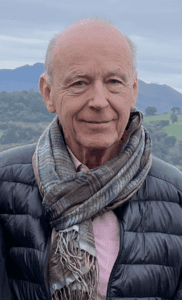
Anthony McCall, artist: [00:01:16] Thank you. To address the most difficult question first. I suppose the truth is that from a young boy I drew. The art room at school seemed to be the most hospitable place around. I spent a lot of time hanging out there. I also discovered, when in my teen years, that I had a sort of feeling for judgement, that is aesthetic judgement. I could look at a picture and decide if it was any good or not. This came as a revelation. It was sort of a discovery. There seemed to be little doubt that I go to art school. Which I did in 1964.
Neil Koenig, ideaXme interviewer and board advisor: [00:02:06] Was it easy to choose the art school?
Anthony McCall at Ravensbourne College of Art and Design
Anthony McCall, artist: [00:02:08] You know, like all of us, we applied for more than one. It wasn’t that difficult. There were some that seemed more interesting to me than others. I was particularly interested in the art schools with a more conceptual bent or let’s say more Bauhaus than Picasso. And so that rather narrowed the field. And I eventually ended up going to Ravensbourne College of Art and Design, which was a four-year degree course. In those days there were different kinds of art schools, those that required A-levels and those that didn’t and so on and so on. So, I eventually ended up at one that did.
Neil Koenig, ideaXme interviewer and board advisor: [00:02:56] And whilst you were at Ravensbourne, you actually studied graphic design.
Anthony McCall, artist: [00:03:01] I studied graphic design and photography as my main subjects, and there were also academic studies which were basically philosophy. The odd thing was that all my friends were in the painting department, which was on the top floor. And I was in the graphic design department and learnt typography from Ian McLaren, who had been in Ulm, which came after the Bauhaus. And, had an approach to typography, which was very disciplined and what now would be called information graphics, graphic design to do with sign systems and with Olympic symbols, that kind of thing.
Neil Koenig, ideaXme interviewer and board advisor: [00:03:55] Were you also able to develop your skills in drawing?
Anthony McCall, artist: [00:03:59] Funny thing is that everything I learned about drawing, I learned almost before I went to art school and perhaps in my foundation year and the rest, I’ve been trying to catch up ever since.
Neil Koenig, ideaXme interviewer and board advisor: [00:04:12] After attending Ravensbourne, were you clear about what your next move was going to be?
Anthony McCall, artist: [00:04:18] No, none whatever. It seemed impossible that one could have a career doing this kind of thing. I was already certain that I was not going to set out to be a graphic designer for the rest of my life. But I didn’t know what I would do. And I basically hung out with friends who I liked talking to and with. And eventually some of those friends became collaborators and we made things together and it became our work.
Neil Koenig, ideaXme interviewer and board advisor: [00:04:56] And that was in London?
Anthony McCall, artist: [00:04:58] That was still in London, yes. I was in London until the beginning of 1973. And but those friendships continued throughout the 70s and became pretty much the centre of centre of my “art critical life” if you like. My particular friend was Anthony Howell, the poet, and the founder of Theatre of Mistakes in the 70s. And he and I spent a lot of time together just talking. I gradually developed a sort of, I suppose, what you would call a practice.
Neil Koenig, ideaXme interviewer and board advisor: [00:05:36] What was the art scene like in London and the UK at around that time?
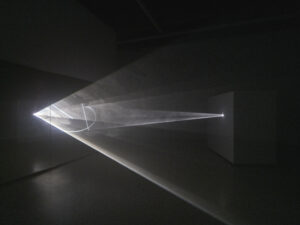
Anthony McCall, artist: [00:05:44] So we’re talking the late 60s and early 70s. Well, there was more than one art scene, as I suppose is the answer. I suppose we shouldn’t start with the galleries, but that is indicative. Galleries like the Lisson Gallery were showing some of the best work coming from America, particularly minimal post-minimal and conceptual work. There were galleries like Nigel Greenwood, who had a more international, perhaps more British bent. So, he had Gilbert and George and artists like that. And I and my friends went to the openings of these galleries, but we were half a generation younger than the people that were being shown, so we had to find our own way and found a lot to interest us.
Neil Koenig, ideaXme interviewer and board advisor: [00:06:46] So what were the first ideas that you embarked on putting into practice? Did you do any of this before you left the UK?
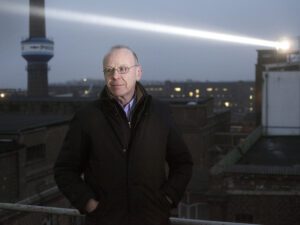
Anthony McCall, artist: [00:06:56] Oh, yes, I was already I count the start the starting point when I began to self-consciously make art would have been 1971. I had a table, a carousel projector, a Pentax camera, and that was just about it. I began to do the thing that seemed the most natural thing to do was related to performance. It was always time based. And I began to say, for instance, I would make I made a series of works made for the carousel slide projector, which is an 81-slide magazine loaded machine. I also began making performances in landscape. These were based on grids of small fires in the middle of nowhere, and that, in turn, led me to filmmaking. Because if you make a time-based work that occurs in the middle of nowhere, it’s doomed to disappear immediately. And it seems like documentation, you know, performance in a way did always presuppose documentation but I hadn’t at that point made a film. So, I set about learning how to and I made a film. The first film I made, in fact, was called Landscape for Fire, and it was one of the ostensibly the documentation of a performance turned into a lot more than that, though, as I found the medium of film to be extremely interesting.
Neil Koenig, ideaXme interviewer and board advisor: [00:08:42] Landscape for Fire, that was filmed in the London area, wasn’t it?
Anthony McCall, artist: [00:08:46] That was filmed in North Weald. Yeah, at the end of the Central Line. That was made in 1972. Friends taught me how to edit and we shot the piece really without rehearsal. Then I edited it together. And found that I had not a piece of documentation at all, but the film in its own right.
Neil Koenig, ideaXme interviewer and board advisor: [00:09:15] Can you remember what sort of response you got to the work at that time?
Anthony McCall, artist: [00:09:20] Of course, at that time, the people that looked at the sort of work I made, or Anthony Howell made were friends who made similar kinds of work. And there really wasn’t a general public. So, we were showing to one another. It was like a milieu. He created a kind of a critical centre which gave us quite a lot of ammunition to work with. So, the response mainly came from other artists. Many of whom were also doing performance. And so, I think it’s fair to say that I had a favourable review, but I’m not sure how high a standard that was.
Neil Koenig, ideaXme interviewer and board advisor: [00:10:14] And then in the early 70s you moved to New York. Why did you do that?
Anthony McCall, artist: [00:10:21] Well, at the time I had met and was living with an American painter and performance artist called Carolee Schneemann, and we were living together. Coincidentally, a number of things happened together at the same time without being attended to. One was that I was offered a fellowship from The Gulbenkian Foundation (The Calouste Gulbenkian Foundation) to go to New York for six months. The other was that some of Carolee’s friends were sick and she was anxious to see them. And so more or less we moved to New York, without quite intending to. She still had her old loft that had been sublet. And I had my grant and we stayed on, and on.
Neil Koenig, ideaXme interviewer and board advisor: [00:11:17] And what did you find when you got to New York?
Anthony McCall, artist: [00:11:21] Well, I found very much as I had in England, which is that there’s always more than one scene. But what was particularly interesting about the scene in New York, to me anyway, was that it seemed to take place around the bar, and that was Max’s Kansas City on Central Park South, which had a collection. Collection was formed by Mickey Ruskin, the owner, by trading a tab for a bar tab for a work of art. And it was overwhelming. You walked into this bar dominated by a John Chamberlain sculpture made of made of galvanised iron. There was a silhouette in the corner. There was a Dan Flavin over there. There was a Mel Bochner, there was a Dorothea Rockburne drawing. It was like being in a gallery, except it was a bar and restaurant. And then in the back row and at night, of course, it was really the central place where artists went to meet. And so, life there would be late. A very mixed kind of art was being made there and it was right around the corner from Andy Warhol’s The Factory, on Union Square. And so, every night The Factory people would be there. They were always in the back and in the darkest part of the room, and there was always Warhol and Brigid Berlin recording things on their tape recorders and so on and looking inscrutable. And it was an introduction. It was a very good place for a young artist to go and meet other artists. It was a very active social, artistic scene. I’d never come across that before.
Neil Koenig, ideaXme interviewer and board advisor: [00:13:29] Nothing really like that in London that you had encountered?
On arriving in New York, Anthony McCall Meets Sol LeWitt and Mel Bochner
Anthony McCall, artist: [00:13:32] No. And also, I must say that the English are more reserved than the Americans. And I was struck by how hospitable the American artists were to me when I first got off the boat, so to speak. And I did in fact call the two artists that I wanted to meet. One was Sol LeWitt and the other was Mel Bochner, both conceptual artists. Both very interesting in my opinion at that time. So, I thought I would only have one chance to say I’m off the boat. So, I called each of them separately and telephoned to see if I could maybe meet them. And both of them were working from the same script. Both said: “Where’s your studio?” I said: “Well, it’s on 29th Street, Sixth Avenue!” They said: “Give me the address and I’ll come over”. And both of them did within 2 or 3 weeks of my calling them. They spent an hour or two in the studio talking about work. And from then on, I knew them. I couldn’t really have quite imagined it happening quite that way in London. It’s not that one needed an introduction, but there weren’t those easy entry points for socialising.
Neil Koenig, ideaXme interviewer and board advisor: [00:15:10] Meanwhile, how were your own ideas developing and what impact do you think the new setting had on the development?
Anthony McCall, artist: [00:15:19] Having made this one film of Landscape for Fire and having become interested in the medium of film, I’d begun to think about what the problems were with what I’d made. One of the problems that I felt that I had with my film was that it was all very well, but when I took it round and showed it to, you know, typically at an art school or to colleagues, I became aware that I wasn’t really showing the performance. I was showing a film of the performance. So, I began to ask the question as to whether it would be possible to make a film that was itself a performance. And this was the sort of thinking that quite a lot of other artists were putting their work through. Eventually I came up with an idea which I tested out in my studio and in a piece called Room with Altered Window, where I’d simply masked out the whole window except for a slit which I would leave open and then I would light a cigarette. To my pleasure the idea had seemed looked like it would work, which is if you allow a shaft of light into a room and there’s some particulate in the air, like tobacco smoke, you would see a three-dimensional blade of light cutting through the room. And that proved to me that the idea would work. And so, a month or two later, I made Line Describing a Cone, which is a half an hour film that takes the form of a white dot on a black background that very slowly turns into a circle on the screen until half an hour later, you have a complete circle. Now, in three dimensional terms, and assuming some particulate in the air like cigarette smoke or dust, what happened was not a line turning into a circle. But a line turning into a cone, a three-dimensional object, which had all kinds of qualities. You could walk into it, out of it, under it and over it. You could touch it. You could move through it.
Neil Koenig, ideaXme interviewer and board advisor: [00:18:04] Now something unusual was happening. Instead of looking at the screen, the audience would have been looking in the opposite direction.
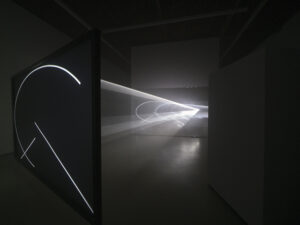
Anthony McCall, artist: [00:18:12] That’s exactly right. I would introduce the film because after all, our habits die hard, all of us kind of room. You see a screen; you stare at it. And my suggestion here was that they turn their back to the screen and face the projector. And look at what happens between the projector lens and the wall. That became the guiding principle for all of the solid-light works. It did not seem to be a great difficulty for the audience who again, as I said, were probably mostly artists themselves. And so that was really the beginning of what became a series. I think I’m in my 46th work at the moment.
Neil Koenig, ideaXme interviewer and board advisor: [00:19:05] What was the space like where you where you showed this, first of all?
Anthony McCall, artist: [00:19:10] This is the moment when in Soho there are all these empty lofts which were gradually being requisitioned by artists as very cheap studios. And so there was a lot of dust in the air. I think my first showing in New York was at Artists Space, which was a newly founded, not for profit the young artists to show work in. And I think it was shown for the first time in London at London Film-makers Co-op.
Neil Koenig, ideaXme interviewer and board advisor: [00:19:38] But the key breakthrough was lighting the cigarette in the room with the with the covered partially covered window?
Anthony McCall, artist: [00:19:47] That was when I realised that the idea would work. I think the idea being that a projected a film could be three dimensional. And simply by I think in a way, the key idea is to ask your audience to turn their backs to the screen. The thing about the dust, cigarette smoke was accidental. It was a few years later that I discovered that it was absolutely essential. It never occurred to me that I was working with a medium I didn’t know about, the medium being dust because these were old factories and they’d been sweatshops and small machine manufacturers and so on, and they were full of dust, rough floors. And in those days, somehow every third person smoked. And so, for a while I had absolutely no idea that I might be having a visibility problem coming down the pike to meet me, which I did when I showed Line Describing a Cone at the Malmö Konsthall, Malmö in Sweden in about the mid 70s, and it was about 1975. And to my surprise and horror, the film, which was well attended by the local burghers, failed to materialise. But I did have was this a line turning into a circle. It was then that I realised that I actually had overlooked something, and they went off and got some Swedish cigarettes and came back puffing furiously and was immediately asked to leave by an angry guard. Quite seriously, it was that moment when I realised that I had a problem that I hadn’t solved and had to address, and that was actually very difficult.
Anthony McCall, artist: [00:22:02] I made six films of that kind in the 70s. The duration of these pieces getting longer and longer. The one, for instance, Long Film for Four Projectors lasted five and a half hours. Now, this is also the moment when I was rethinking the idea of the audience. That this idea worked better if one thought of the work installed as an installation rather than as a movie shot shown on a screen and installation form asks that people can come and go on their own time. So, I began to work in that way. So, the longest of those films was five and a half hours. Not with the idea that the visitor was supposed to spend five hours there, but rather that they were visitors, not members of an assembled audience, and that they would choose exactly how long they wanted to stay or not stay. So, I suppose this is the beginning of period when installation got a lot of currency and became a kind of word. It’s also the moment when the art world was coming to terms with time, with things in motion. So, you had sound arts and you had slide work and you had films and you had performance, and all these kinds of forms were time based and very often became installation based. They really did significantly change what was going on aesthetically in the art world where painting was still a dominant form, still is.
Neil Koenig, ideaXme interviewer and board advisor: [00:24:01] Yes. I mean, today the idea of an installation seems reasonably familiar, but in the 70s it must have seemed quite new.
Solid-Light Work was Performance and Sculpture
Anthony McCall, artist: [00:24:10] Yes, it’s become the default now. It was invented as we were going along. Solid-Light work was a number of things. It was a film. It had a sculptural face. It was sculpture and arguably it was performance in the sense that when somebody came in and walked around looking at the work and engaging with it, being inside it and walking around it. They were also looking at other people doing the same thing. And that in a way, without pushing it too hard, made it into a kind of a quasi-performance. So, the sculptural face was obvious, and it developed from there, really.
Neil Koenig, ideaXme interviewer and board advisor: [00:24:59] And it wasn’t just a visual experience, was it? There would have been perhaps in the days when everyone smoked, there would have been the aroma of cigarettes and there would have been the sound of the projector and of the rest of the audience.
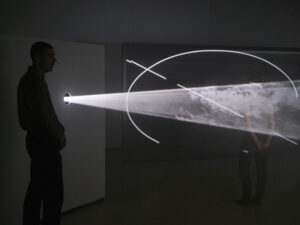
Anthony McCall, artist: [00:25:13] Yes, that’s perfectly true. And things like the sound of the projector did, in fact, become quite an important part of the form that some of the works took.
Neil Koenig, ideaXme interviewer and board advisor: [00:25:30] You talked a little bit about duration and the sense of perhaps an arc of time under which a work unfolds. Is there a kind of shape or a narrative that you’re following with that?
Anthony McCall, artist: [00:25:45] Only that time was the common denominator for all of these ideas, whether it was the structure of the work which, you know, had to do with the shape it would take in space and, and how it was organised through time. It was a question of speed. You know, an object in space can take place at speed very slowly, very fast.
Neil Koenig, ideaXme interviewer and board advisor: [00:26:22] Well, the question of speed is an interesting one, because if you have something that moves fast, that has a different impact on the audience to something that moves slowly.
Anthony McCall, artist: [00:26:35] Yes. Well, that’s a very good point and entirely true. And in fact, I developed an aesthetic of slowness over the years because I discovered that when it’s one thing to look at high speed movement on a movie screen, we can all do that with ease. We can make out all kinds of multiple storylines and God knows what, however fast or slow the motion. But when you put a sculptural object into space. And you make it move too fast. Let’s say you just make it move fast, our tendency as visitors and members of an audience is to stand stock still. And to watch whatever it is to see what might transpire. Now, looking at sculpture requires moving your own body around. And so, to create a form that prevents you doing that was self-defeating. And I gradually realised that the way to deal with this was to make a rule about speed. And my basic principle was that the fastest object in the room should be a member of the audience, not the sculptural form. And that worked quite well because if you came into a room and at first sight, there was nothing moving at all, or maybe moving something so slowly you hadn’t noticed, and you would become comfortable in your sculptural examination of the object. And then when you discovered that its things would change that were paradoxical. Like for some reason, the plane of light that was over there five minutes ago seems to have moved. And so, it increased some difficulties into the viewing process, which were exactly what it needed.
How Cleaning Up Air in Galleries and Exhibition Spaces Affected the Work
Neil Koenig, ideaXme interviewer and board advisor: [00:28:47] Now, you encountered some difficulties, as you’ve mentioned, with the cleaning up of the air in galleries and exhibition spaces towards the end of the 70s, was that a factor in leading you to take a break from working in art for quite a while?
Anthony McCall, artist: [00:29:11] No, it wasn’t really a factor. I did stop making art for about well over 20 years. By the end of the 70s, I felt I’d come to complete this series of Solid-Light works. I thought, that’s done. I thought I’d take a break for a bit. Little realising how long that break would last. There were other issues that were difficult. One of them was that I was about 30 at that time and still no idea exactly how I was going to make a living. And I began editing and designing art books for a living. So, I took up graphic design, which, of course, I studied at Ravensbourne. And although I didn’t wish it particularly and didn’t anticipate it, I was doing that for a well over 20 years. Oh, another problem was that the galleries and the museums might have been interested in this kind of work, which got called expanded cinema, structural film, new American cinema, and all kinds of names. They might have been interested in it. They would even be hospitable to it for one night. But basically, showing time-based work of this kind was simply not what a gallery did and nor did most museums. So, there was that complete embargo on being able to show the work. No way to make a living from it. And then finally there was the most challenging problem of all, which was that of visibility. I tried everything. We tried burning frankincense, which created a light smoke; dry ice which was useless because it hugged the floor. We tried all kinds of ways to replace the cigarette and without much success. And so, all those difficulties really deep created a major problem and something of a crisis, actually. And it was many decades before he was able to solve the problem, partly with the aid of the haze machine, which was a new a piece of kit, which was appearing in the film and theatre world for the making of effects, basically. And that proved to be extremely flexible and very effective. We didn’t need very much of it, but it would make visible these planes of light very, very clearly.
Neil Koenig, ideaXme interviewer and board advisor: [00:31:50] So after this break of quite a while, the haze machine appears on the scene. And then what happened was, was it you saw this machine and thought, aha, I can now pick up the threads of where I was 20 years ago?
Anthony McCall, artist: [00:32:06] No, not exactly. Other things happened and the other things were video art, which took all kinds of forms. But one of the results of that was that some of the commercial galleries began to take an interest and scented it as a possible place to new kinds of work to show. So, to me, that was helpful because it did leave the door ajar from that front. But most important, it was actually a very effective way to deal with this problem of visibility. It must be said also that I was now looking again at moving image art, particularly this new video art, and finding it on the whole with some exceptions. But finally on the whole, unambitious and in the early days of expanded cinema and all those other names, it was quite a rigorous discourse around it and around the politics of non-Hollywood film. And so, all those kinds of debates were circling around the work as well. And I just came to a point where I thought it was time to throw my hat in the ring again. And I began to look quite carefully at what people were making. But also, I was returning to my earlier pieces and looking at them and seeing what they suggested. And I got that actually in the end where I got the new ideas from which I’m still working on.
Neil Koenig, ideaXme interviewer and board advisor: [00:33:51] So what was your first venture when you were back into creating art again?
Anthony McCall, artist: [00:33:57] It was to make a Solid-Light work called Doubling Back. This included more than just the usefulness of a haze machine. It included a little bit of rethinking of how work was shown, projected work might be shown in the gallery space. So, in that particular work, I had the projector in the corner of the room and instead of projecting down the middle of the space, I was projecting down the side of the space in parallel to the wall of the room. I was also exploring the way in which the film projector itself had the ability to alter, to change, to bend out of shape what you were looking at, simply by projecting the real film, not just the one where it was supposed to be rejected, but all four, which is to say forwards, backwards, forwards, back to front, backwards, back to front. That produced four different movements in space. So that particular work was called Four Projected Movements, and it was also defined as an installation, which is to say that it took an hour or so to go through the four permutations, but then that fourth permutation just joined up with the first and it was a continuous installation. So, it included a lot of ideas, all drawn from various places and focussed on this one work and those explorations continued.
Anthony McCall, artist: [00:35:47] The next thing I discovered was that if you’re using a video projector rather than a film projector, then you may not be as limited with what the format would be. So, for instance, it would be possible to have a vertical work, to have the projector on the ceiling ten metres up, projecting onto the floor ten metres below, creating a tent like sort of tepee shape and the machine would not fall apart. If it had been a film 16mm film projector put up on the up on the ceiling, not only would it be extremely dangerous thing to do because it weigh how much it weighed, but the almost certainly the reels would fall off and the whole thing would collapse. So, this was the first, as it were, value added that got out of video. The discovery was that the projection was a little more flexible.
Neil Koenig, ideaXme interviewer and board advisor: [00:36:58] And did that change the way the audience would interact, or the visitors would interact with the piece?
The Visitor Occupied that Vertical Conical Space
Anthony McCall, artist: [00:37:06] Oh, yeah. I mean engaging with a vertical work was quite different from with a horizontal work you were more immersed inside the horizontal form. Imagine a conical form of that is horizontal that’s thirty feet, only ten metres long, whereas the vertical one, it was more, well, it was almost architectural. The visitor kind of occupied that vertical conical space. Sometimes inside of it, sometimes outside of it. But it was treated very much, I thought, in a very interesting way, in that it was treated as a solid object. So, if there was, let’s say there’s an aperture in that cone of light, that aperture would be treated by the visitor as a kind of door. They would go to quite extreme lengths to go through the door rather than go through walk through a veil of light. And things like that became quite interesting and I was able to develop some ideas around those phenomena.
Neil Koenig, ideaXme interviewer and board advisor: [00:38:27] So did you find that the responses of audiences surprised you, sometimes?
Anthony McCall, artist: [00:38:35] No. Not really because, we were showing, again coming back to being what generation you from. You know, my generation was making this kind of work and was used to its rules and hospitable to the ideas. And as I said, there wasn’t really a public then. The people that came to the screenings or showings or installations or whatever you’d like to call them were other artists on the whole, or people that were professionally interested in art critics or whatever. So, the difficulties were rather admired rather than creating problems.
Neil Koenig, ideaXme interviewer and board advisor: [00:39:31] But if we come up to the present or more recent times, let’s say you have a show in a darkened space and you have an audience who turn up or visitors who turn up with a lot of smartphones. This might alter the impact of your works in some way.
Anthony McCall, artist: [00:39:53] Yes, Well, that’s perfectly true. The smartphone is an interesting example. I have nothing particularly against people going around with their smartphones. And I’ve learned to accept it as a given. But when you have an installation in which relies on darkness on the one hand and legibility on the other, half a dozen people with smartphones can be quite disruptive, really, just because of the sheer brightness of the screen. The screen of a smartphone is considerably brighter than the brightness of a plane of light being projected through a room. But it hasn’t become a major problem. It’s just sort of one of those things that seems to come with the territory and become with the culture. And I dare say at some point it’s going to find a way into the pieces I’m making. But so far, it’s been a peaceful coexistence.
Neil Koenig, ideaXme interviewer and board advisor: [00:41:00] So going back to the kind of development of the solid light works, can you talk us through a couple of other examples from recent years?
Anthony McCall, artist: [00:41:15] Yes. We already started with Line Describing a Cone, which is unusually and unlike all the others is a narrative film denounces its purpose and delivers it. It has a beginning, a middle and an end. All the things. You know, I must say that this kind of work saw itself as anti-narrative. But that was not noticed with this work. It was just as well. Let’s jump to a middle, a middle period work, say 2010. I made a group of works called Face to Face, and they were double projections, they were horizontal first of all. And there were two projectors, one facing one direction and one the opposite direction. They were alongside one another. And the thing that interested me then was, I’d been quite successful in making works which were uni directional. Screens over there. Projectors over there. And you’re in the middle. But it was still an object in space that was that only went in one direction. And I began to play with the idea of being able to do both, being able to both be inside the volume of the volumetric form and explore it sculpturally at the same time but looking, don’t forget, the projectors are going in opposite directions. So, the screens are at opposite ends of the room. So being both inside the volume, but also able to read the, what I call the footprint, the line drawing on the wall on the screen. So, to be inside the form and see how it’s made seemed to be quite an interesting problem. And so, I made a group of these all called Face to Face, one, two, three and four, which explored that idea of being able to do both at once, to have both sides of the equation legible.
Anthony McCall, artist: [00:43:41] And if we jump forward to 2020, something like that. I began to think that the same effect, the same result would be possible with only one projector. Even more simply than having the projections going in opposite directions, just have a single projector. But instead of projecting onto a screen in the middle of the room, I would project onto a mirror. And so, if you imagine a room, you have a projector we’re projecting straight through the room, but instead of going the full ten metres and becoming a line drawing on a wall, we would go half that distance five metres and it would hit the mirror and it would return to the wall that concealed the projector. So, it’s like skinning a rabbit. You know, we’ve skinned the thing inside out. What was quite strange about the effect of this is that a mirror does set the thing as you expect it to do but then it does a lot more. It does a lot of other things. What we ended up with was, we ended up with the double cone again. Except it was made with only one projection and a mirror. You still could still walk around it. And the interesting thing to me about the projection was that there was a second projection passing through the first in the opposite direction. This is all the result of the mirror now, not the result of my double projection. And I’m still exploring that idea because the one that I’ve just I’m in the process of finishing.
Anthony McCall, artist: [00:45:42] I’ve got this same structure with the single projector projecting onto the mirror halfway down the beam, so to speak. But instead of having it bounce straight back, I put the mirror at a 45-degree angle to the plate, to the beam of light. So that the projection goes from the projector to the mirror, and then it takes a sharp right because off to the one side and then it alights on a translucent two-sided screen. So, we have we have a more complex installation than we had with the first mirror piece. The thing is, they’re both quite uncanny and quite odd because the point is that when you’re walking around looking at either of them, you can’t actually be sure which is the actual image of light, and which is virtual. There is no difference visually. And I came across this in a humorous way, I suppose, which is I was in my installation talking to a friend about the piece and I noticed out of the corner of my eye that there was someone coming toward me that looked familiar. And identified as a friend. And when they arrived, for what I took, I began to have conversation I discovered it was myself. That I had actually seen myself approaching and I hadn’t actually recognised in this slightly misty room. I hadn’t at the time recognised that the virtual and the actual coexisting and were not terribly different from one another. I found that uncanny and, it still it doesn’t matter that you know this. It still works as a surprise.
Neil Koenig, ideaXme interviewer and board advisor: [00:47:49] So this is one way that you find ideas emerging then is to experience your own works?
Anthony McCall, artist: [00:47:57] Always. There’s a certain moment in, I suppose, any artist’s life where your own ideas become more vivid than anyone else’s for yourself. And you just sort of get on with it. And I’ve always found that I get my fresh ideas from reconsidering earlier ones or finally finding a gap, or finding a fault or finding, an intriguing idea or whatever it might be. And that I tend to draw on previously finished work for new work.
Neil Koenig, ideaXme interviewer and board advisor: [00:48:42] Can you tell us about the show in Los Angeles?
Anthony McCall Installs Split Mirror Three
Anthony McCall, artist: [00:48:46] I’d be happy to, yes. First of all, there is an upstairs room where we have historical drawings, drawings from the 70s and points north from there, which are mostly framed drawings of different kinds. There are duration drawings there. There are all kinds of things. And then on the main floor, there are two thirty-foot square rooms. In the front room, there’s a work which follows the idea I just described about the beam of light being deflected by the mirror. We have that piece, which is called Split Second Mirror Three. It’s the first time I’ve actually been able to install it. I was quite satisfied with the way it looked and behaved and there were some surprises. And it’s this piece that I intend to develop further. In the back room was a work called Skylight, which is one of the other things I’ve been exploring in the last three or four years, really since Covid started, is the use of sound. And I haven’t done that extensively, though one of my earliest works was a sound piece.
Neil Koenig, ideaXme interviewer and board advisor: [00:50:07] The drawings that are on display will give audiences some insight into your working methods then perhaps? I mean, you seem to do a lot of planning and thinking before anything is actually installed in the gallery.
Anthony McCall, artist: [00:50:23] That’s perfectly true. But I don’t really have a drawing style. I have notebooks which into which everything goes, and I’m up to a notebook 160 at this point. The notebook is, with a pencil, where I start with an idea and then it goes to a larger sheet of paper and then it may go to a quite formal score. I think of this as musical scores sometimes when I’m in production. They often diagram what the structure of a piece is. So, yes, you’re right taken as a whole, the drawings would offer some clues as to how the works are structured and how I think about them.
Neil Koenig, ideaXme interviewer and board advisor: [00:51:13] And do you make models?
Anthony McCall, artist: [00:51:16] Oh, yes, I do. The first models that were really absolutely necessary were for Face to Face, the piece I described which have a screen at each end, a projector at each end, and the projection onto the screens with two sided screens so you could read them from front or back. And they became a little bit too complicated to represent for myself on a printed page. On a notebook. I discovered that the best way to deal with that problem was to build a model. So, I made a little bent paper, cut out paper models at three-minute intervals of an entire work. And the great thing is that you can hold the thing up and you can move yourself around it. Then you can look at the three minutes later and three minutes earlier, using this very, very simple device of a paper model, you can actually get a great insight into what is you’re up to, which I simply couldn’t do in my head or just with a two-dimensional drawing.
Neil Koenig, ideaXme interviewer and board advisor: [00:52:37] And what’s coming up? What’s next? What’s your next show going to be?
Anthony McCall, artist: [00:52:42] I have two shows coming up. One will take place in Czech Republic in October, at a place called Galerie Rudolfinum. It’s a show called CO-EXTENSIVE, which opens in October this year, which is a group show more or less conceptual work by, I think, something like a dozen artists. That’s the next time I’ll have a work on display. And then after that, it’ll be next year in July when I have a show at Tate. Tate Modern, which will open, have to keep the dates around to remind me to don’t panic. That will open in June, on June 24th and it will run for about ten months.
Neil Koenig, ideaXme interviewer and board advisor: [00:53:44] And what can we expect to see in that?
Anthony McCall, artist: [00:53:48] The idea, I think for Tate Modern of this series that they’ve been gradually creating was to take works from the collection that they’ve considered worth building something around and inviting the artist who made it to create a show around the work that they had pulled up to begin with. So, they selected Line Describing a Cone, as the starting point. And I spent I’ve spent a few months thinking about how, with them, thinking about how we might represent its place in other people’s work. And so, we’re making we’re basically curating an exhibition at the centre of which is a Line Describing a Cone and the round which all the other works like couple of the ones we’ve already mentioned there’ll be, for instance, there’ll definitely be a mirror work. There’ll definitely be a Face to Face. There might be a doubling back. So, there’ll be something like eight or nine works, which together, collectively will form a kind of picture of what the originating idea was and how it developed over time.
Neil Koenig, ideaXme interviewer and board advisor: [00:55:20] Well, we’ll look forward to seeing that. Anthony McCall, thank you very much.
Anthony McCall, artist: [00:55:26] My pleasure.
Interview credit: Neil Koenig, former BBC Producer and now ideaXme board advisor.
If you enjoyed this interview check out our discussion with Curator, Marcello Dantas.
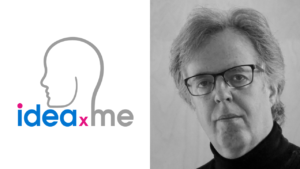
Neil Koenig: LinkedIn https://www.linkedin.com/in/neilkoenig/
ideaXme links:
Connect with the founder, Andrea Macdonald.
ideaXme is a global network – podcast on 12 platforms, 40 countries, mentor programme and creator series. Mission: To Move the human story forward™. Our passion: Rich Connectedness™!

